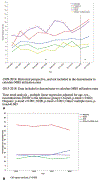Disparity Between United States Adolescent Class II and III Obesity Trends and Bariatric Surgery Utilization, 2015-2018
- PMID: 32941272
- PMCID: PMC9825050
- DOI: 10.1097/SLA.0000000000004493
Disparity Between United States Adolescent Class II and III Obesity Trends and Bariatric Surgery Utilization, 2015-2018
Abstract
Objectives: Class II (120% > body mass index [BMI] < 140% of the 95th percentile for age and sex) and Class III (BMI >140% of the 95th percentile for age and sex) obesity are the fastest growing subcategories of obesity in the United States pediatric population. Metabolic and bariatric surgery (MBS) is a safe and effective treatment option for with class II/III obesity. The primary objectives of this analysis were to determine the (1) current US MBS utilization rates in those with class II/III obesity and (2) utilization rates and 30-day postoperative outcomes.
Background: The 2015 to 2018 National Health and Nutrition Examination Survey cross-sectional data (N = 19,225) generated US with class II/III obesity prevalence estimates. The 2015 to 2018 Metabolic and Bariatric Surgery Accreditation and Quality Improvement Program (MBSAQIP) longitudinal (30 days) cohort data were used to compare adolescent and adult (N = 748,622) postoperative outcomes and to calculate utilization rates.
Methods: The 2015 to 2018 youth and adult MBS utilization rates were calculated using MBSAQIP data (numerator) and National Health and Nutrition Examination Survey data (denominator). Two-sample tests of proportions were performed to compare the MBS utilization rates by age, ethnicity, and sex and expressed per 1000.
Results: Mean age of the analytical MBSAQIP sample was 17.9 (1.15) years in youth (n = 3846) and 45.1 (11.5) in adults (N = 744,776), majority female (77.4%, 80.7%, respectively) and non-Hispanic White (68.5%, 59.4%, respectively). The overall 2015 to 2018 MBS utilization rate for youth was 1.81 per 1000 and 5.56 per 1000 for adults ( P < 0.001). Adult patients had slightly higher percentage (4.2%) of hospital readmissions compared to youth (3.4%, P = 0.01) but there were no other post-MBS complication differences. From 2015 to 2018 the US prevalence of youth with class II/III obesity increased in Hispanics and non-Hispanic Blacks (P trend < 0.001), but among youth who did complete MBS non-Hispanic Whites had higher rates of utilization (45.8%) compared to Hispanics (22.7%) and non-Hispanic blacks 14.2% (P = 0.006).
Conclusions: MBS is an underutilized obesity treatment tool for both youth and adults, and among ethnic minority groups in particular.
Copyright © 2020 Wolters Kluwer Health, Inc. All rights reserved.
Conflict of interest statement
The authors declare no conflict of interests.
Figures
References
-
- Armstrong SC, Bolling CF, Michalsky MP, et al. , SECTION ON OBESITY, SECTION ON SURGERY. Pediatric metabolic and bariatric surgery: evidence, barriers, and best practices. Pediatrics. 2019;144:e20193223. - PubMed
-
- Kelly SA, Barlow SE, Rao HG, et al. , American Heart Association Atherosclerosis, Hypertension, and Obesity in the Young Committee of the Council on Cardiovascular Disease in the Young, Council on Nutrition, Physical Activity and Metabolism, and Council on Clinical Cardiology.. Severe obesity in children and adolescents: Identification, associated health risks, and treatment approaches: a scientific statement from the American Heart Association. Circulation. 2013;128:1689–1712. - PubMed
-
- Rank M, Siegrist M Wilks D, et al.The cardio- metabolic risk of moderate and severe obesity in children and adolescents. J Pediatr. 2013;163:137–142. - PubMed
Publication types
MeSH terms
Grants and funding
LinkOut - more resources
Full Text Sources
Medical


